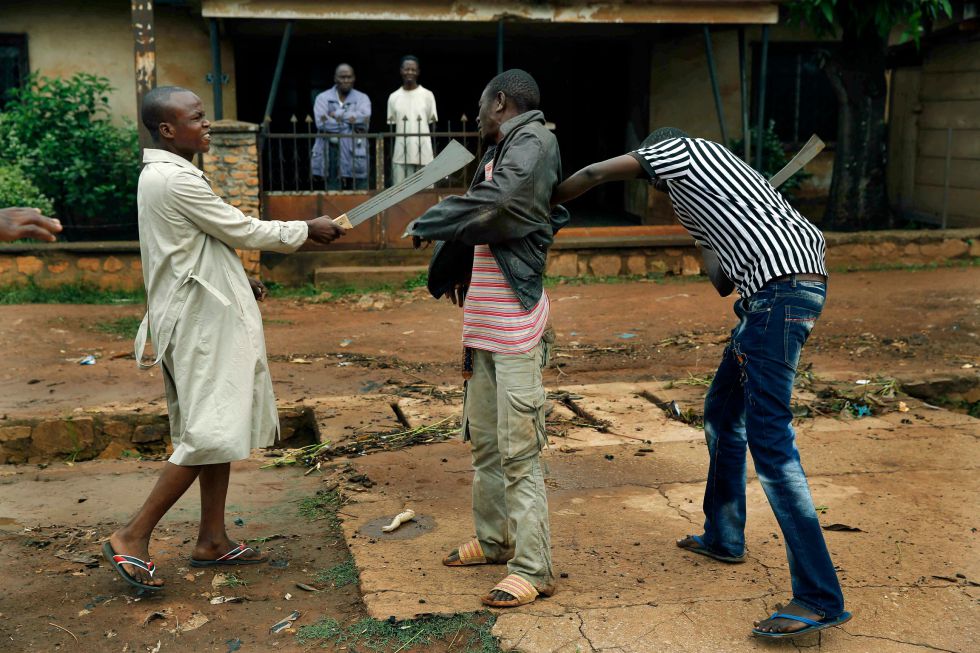
Published in 2013: the year in pictures (El País). Credit: Jerome Delay (AFP). Click the image to visit the original source.
This is one of the pictures the year has left. In it, two Muslim militiamen armed with machetes are registering a Christian in the Miskine neighborhood, in Bangui (Central African Republic), December 13, 2013. About 1,600 and 3,000 French soldiers already there of the African MISCA international mission were not able to stop violence and chaos.
Both in this case and in other armed conflicts, there are political motivations, ultimately rooted in inequality and poverty.
The maps below are a series edited by GRID Arendal that, at least, invite us to think. It’s the first thing I show my students every year when I start my course on Soil Science at the university and I encourage them to discuss their reasons and responsibility as soil scientists. I also invite you to take a look. Original sources include detailed descriptions, images and PDFs.
Is poverty in West Africa related with soil quality?

Child mortality and land degradation. Credit: Emmanuelle Bournay, Philippe Rekacewicz, UNEP/GRID-Arendal. Click to visit the original source.

Child mortality and agroclimatic zones. Credit: Emmanuelle Bournay, Philippe Rekacewicz, UNEP/GRID-Arendal. Click to visit the original source.

Child stunted and land degradation. Credit: Emmanuelle Bournay, Philippe Rekacewicz, UNEP/GRID-Arendal. Click to visit the original source.

Child stunted and agroclimatic zones. Credit: Emmanuelle Bournay, Philippe Rekacewicz, UNEP/GRID-Arendal. Click to visit the original source.

Adult female literacy and land degradation. Credit: Emmanuelle Bournay, Philippe Rekacewicz, UNEP/GRID-Arendal. Click to visit the original source.

Adult female literacy and agroclimatic zones. Credit: Emmanuelle Bournay, Philippe Rekacewicz, UNEP/GRID-Arendal. Click to visit the original source.
Finally, some statistics. These graphs do not show clear trends, probably because land degradation indicators need much more detail and spatial resolution than currently.

Series of Human Development Indicators based on the levels of land degradation in West Africa. They show the levels of child mortality, stunted growth, primary school enrollment and adult female literacy rates. Credit: Emmanuelle Bournay, Philippe Rekacewicz, UNEP/GRID-Arendal. Click to visit the original source.
Know more
Adaku, A.A. 2013. The effect of rural-urban migration on agricultural production in the northern region of Ghana. Journal of Agricultural Science and Applications 2, 193-201. DOI: 10.14511/jasa.2013.020402.
Aelion, C.M., Davis, H.T., Lawson, A.B., Cai, B., McDermott, S. 2013. Associations between soil lead concentrations and populations by race/ethnicity and income-to-poverty ratio in urban and rural areas. Environmental Geochemistry and Health 35, 1-12. DOI: 10.1007/s10653-012-9472-0.
Belsky, J.M. 1994. Soil conservation and poverty: lessons from upland Indonesia. Society & Natural Resources 7, 429-443. DOI: 10.1080/08941929409380879.
Guedes, G.R., VanWey, L.K., Hull, J.R., Antigo, M., Barbieri, A.F. 2014. Poverty dynamics, ecological endowments, and land use among smallholders in the Brazilian Amazon. Social Science Research 43, 74-91. DOI: 10.1016/j.ssresearch.2013.09.002.
Kabubo-Mariara, J. , Mwabu, G., Kimuyu, P. 2006. Farm productivity and poverty in Kenya: The effect of soil conservation. Journal of Food, Agriculture and Environment 4, 291-297.
Makhanya, E.M. 2014. Demographic dynamics and land degradation at Ratau, Lesotho, in the context of rural sustainability. Land Degradation and Development 15, 257-269. DOI: 10.1002/ldr.613.
Ravnborg, H.M. 2002. Poverty and soil management-relationships from three Honduran watersheds. Society and Natural Resources 15, 523-539. DOI: 10.1080/08941920290069155.
Requier-Desjardins, M., Adhikari, B., Sperlich, S. 2011. Some notes on the economic assessment of land degradation. Land Degradation and Development 22, 285-298. DOI: 10.1002/ldr.1056.
Schreinemachers, P., Berger, T., Aune, J.B. 2007. Simulating soil fertility and poverty dynamics in Uganda: A bio-economic multi-agent systems approach. Ecological Economics 64, 387-401. DOI: 10.1016/j.ecolecon.2007.07.018.
Shively, G.E. 2001. Poverty, consumption risk, and soil conservation. Journal of Development Economics 65, 267-290. DOI: 10.1016/S0304-3878(01)00137-7.
Stitger, C.(K.)J., Winarto, Y.T. 2013. Science field shops in Indonesia. A start of improved agricultural extension that fits a rural response to climate change. Journal of Agricultural Science and Applications 2, 112-123. DOI: 10.14511/jasa.2013.020210.
Swinton, S.M., Quiroz, R. 2003. Poverty and the deterioration of natural soil capital in the Peruvian altiplano. Environment, Development and Sustainability 5, 477-490. DOI: 10.1023/A:1025785231559.
Stephens, E.C., Nicholson, C.F., Brown, D.R., Parsons, D., Barrett, C.B., Lehmann, J., Mbugua, D., Ngoze, S., Pell, A.N., Riha, S.J. 2012. Modeling the impact of natural resource-based poverty traps on food security in Kenya: The Crops, Livestock and Soils in Smallholder Economic Systems (CLASSES) model. Food Security 4, 423-439. DOI: 10.1007/s12571-012-0176-1.
Tavares, J. de P., Ferreira, A.J.D., Reis, E.A., Baptista, I., Amoros, R., Costa, L., Furtado, A.M., Coelho, C. 2013. Appraising and selecting strategies to combat and mitigate desertification based on stakeholder knowledge and global best practices in Cape Verde Archipielago. Land Degradation and Development. DOI: 10.1002/ldr.2273.
Testafye, A., Negatu, W., Brouwer, R., van der Zaag, P. 2013. Understanding soil conservation decision of farmers in the Gedeb watershed, Ethiopia. Land Degradation and Development. DOI: 10.1002/ldr.2187.
This post was also published simultaneously in G-Soil.

Joe
Great question to get more informed soil scientists thinking about.
I remember reading a very old soil textbook in my university library which was talking about fertile soil in East Africa, suggesting that the whole population of the continent could be fed from food grown in the soils of Sudan, Ethiopia etc.
Of course, things have moved on in thinking about Soil Science since the mid twentieth century, but I think it shows that there is an intersection between soil quality and other factors – that we as soil scientists rarely have time to study. There seems to be both a need to introduce soil quality into other fields of study and to introduce more from other fields into soil science.
lingerie
I think I agree with this statement. “This is one of the pictures the year has left. In it, two Muslim militiamen armed with machetes are registering a Christian in the Miskine neighborhood, in Bangui (Central African Republic), December 13, 2013. About 1,600 and 3,000 French soldiers already there of the African MISCA international mission were not able to stop violence and chaos.”